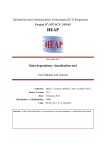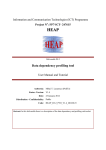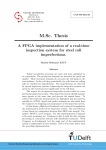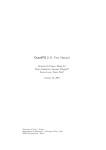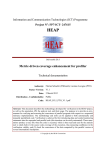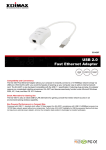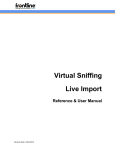Download User Manual for the Free Software Tools
Transcript
Information and Communication Technologies (ICT) Programme
Project No: FP7-ICT- 247615
HEAP
Deliverable D3.6
Parallel code generator
User Manual and Tutorial
Author(s): Mihai T. Lazarescu, Luciano Lavagno (PoliTo)
Status -Version: V1.2
Date: 30 March 2012
Distribution - Confidentiality: Public
Code: HEAP_D3.6_PTO_V1.2_20120402.doc
Abstract:
This document describes the full HEAP flow for software parallelization, with the user-driven data
dependency profile-driven approach. We provide a summary of the data dependency tracing and optimization, and then provide a detailed description of how this information should be used to derive a
parallel software implementation. The operations of a new tool, which is included in the HEAP GUI
to help the developer perform this last step, is also provided.
Copyright by the HEAP Consortium
FP7-ICT-247615 - HEAP
Free Software-Based Flow for the Visualization of the
Parallelism in the Program Execution -- User Manual and Tutorial
Disclaimer
This document contains material, which is the copyright of certain HEAP contractors, and may not be
reproduced or copied without permission. All HEAP consortium partners have agreed to the full publication of this document. The commercial use of any information contained in this document may
require a license from the proprietor of that information.
The HEAP Consortium consists of the following companies:
No
Participant name
Participant
short name
Country
Country
1
ST Microelectronics
STM
Co-ordinator
Italy
2
Synelixis Solutions Ltd
Synelixis
Contractor
Greece
3
Thales Communications
Thales
Contractor
France
4
ACE Associated Compiler Experts B.V.
ACE
Contractor
Netherlands
5
Compaan Design
Compaan
Contractor
Netherlands
6
Politecnico Di Torino
PoliTo
Contractor
Italy
7
ATHENA Industrial Systems Institute
Athena
Contractor
Greece
8
Universita Degli Studi Di Genova
UniGe
Contractor
Italy
9
SingularLogic
SiLo
Contractor
Greece
HEAP_D3.6_PTO_V1.3_20120402.doc
Page 2 of 23
FP7-ICT-247615 - HEAP
Free Software-Based Flow for the Visualization of the
Parallelism in the Program Execution -- User Manual and Tutorial
Document Revision History
Date
Issue
Author/Editor/Contributor
Summary of main changes
2012-03-30
1.0
1st draft
2012-03-30
1.1
Mihai T. Lazarescu
Luciano Lavagno
2012-04-02
1.2
Luciano Lavagno
Minor edits
2012-04-03
1.3
Ioannis Papaefstathiou
Reviewed & Approved
HEAP_D3.6_PTO_V1.3_20120402.doc
Revision
Page 3 of 23
FP7-ICT-247615 - HEAP
Free Software-Based Flow for the Visualization of the
Parallelism in the Program Execution -- User Manual and Tutorial
Table of contents
1. Introduction ......................................................................................................................................7
2. Tool Chain .........................................................................................................................................7
2.1. Source Code Analysis and Instrumentation .................................................................................7
2.2. Run-Time Data Dependency Tracer Library ...............................................................................7
2.3. Data Dependency Visualization ...................................................................................................8
2.4. IDE ...............................................................................................................................................9
3. Demo Virtual Machine ...................................................................................................................10
3.1. Load the Demo Project ..............................................................................................................10
3.2. Run the Demo Analysis ..............................................................................................................13
3.3. Run the Data Dependency Visualization ...................................................................................15
4. New Project .....................................................................................................................................22
5. NetBeans Project for HEAP extensions and ZGRViewer ...........................................................23
6. Excerpts of Code::Blocks Documentation on Creation of a New Project .................................24
6.1. The project wizard .....................................................................................................................25
6.2. Changing file composition .........................................................................................................26
6.2.1. Adding a blank file ..............................................................................................................26
6.2.2. Adding a pre-existing file....................................................................................................28
6.2.3. Removing a file ...................................................................................................................28
HEAP_D3.6_PTO_V1.3_20120402.doc
Page 4 of 23
FP7-ICT-247615 - HEAP
Free Software-Based Flow for the Visualization of the
Parallelism in the Program Execution -- User Manual and Tutorial
Abbreviations
FIFO First-In First-Out
IDE Integrated Development Environment
KPN Kahn Process Network
VM Virtual Machine
HEAP_D3.6_PTO_V1.3_20120402.doc
Page 5 of 23
FP7-ICT-247615 - HEAP
Free Software-Based Flow for the Visualization of the
Parallelism in the Program Execution -- User Manual and Tutorial
1. Introduction
In this section we provide an overview of the parallelization strategy used in the optimistic data dependency-based flow. This makes the report more self-contained and helps the reader to better understand the global picture. Moreover, since the parallel code generation capabilities are embedded in
the same Integrated Development Environment that is used for parallelization visualization, this also
makes it easier to understand its operation. The reader who is interested in more details on the operation of the first two steps of data dependency analysis and visualization is referred to D3.2 for the
data dependency profiling tool and to D3.4 for the dependency visualization tool.
Basically, the parallelization flow consists of the acquisition at run time of several execution characteristics, such as the execution frequencies and data dependencies between the program instructions,
as depicted below.
This is achieved by annotating the C source with data dependency profiling API calls (described in
full detail in D3.1), as follows:
•
heap_enter_function(char *funcName, int sourceLine, ...) and
heap_exit_function(char *name, int sourceLine, ...) used to trace the call
stack.
•
heap_declare(char *varName, int sourceLine, void *address, ...)
and heap_alloc(int sourceLine, void* address, ...) used to trace the address of static, automatic and dynamically allocated variables. For the first two categories, the
name is the same as in the source code. For the latter category, the name is dynamically generated upon every execution of the memory allocation call (based on the source code line where it
occurs).
HEAP_D3.6_PTO_V1.3_20120402.doc
Page 6 of 23
FP7-ICT-247615 - HEAP
Free Software-Based Flow for the Visualization of the
Parallelism in the Program Execution -- User Manual and Tutorial
•
heap_read(int sourceLine, void *address, ...) and heap_write(int
sourceLine, void *address, ...) used to trace at runtime the reads and writes to an
address performed by a statement.
Note that the tracing technique completely solves the aliasing issue. For example, assume that the
following source code:
1
int a, *b;
2
a = 2;
3
b = &a;
4
... = *b;
is annotated as follows:
int a, *b;
heap_declare("a", 1, &a);
heap_declare("b", 1, &b);
a = 2;
heap_write(2, &a);
heap_read(3, &&a);
b = &a;
heap_write(3, &b);
heap_read(4, b);
... = *b;
The dependency is correctly identified as going from line 2 to line 4 of the original code, through
variable a. Line 3 does not generate any read dependency, since &a is effectively a constant at that
point of the code, and &b is not read any further in the code fragment.
The processing of the API calls at run-time results in the collection of data dependencies, where each
dependency is a pair (producer statement, consumer statement) and is annotated, to help the designer
reason about the code structure, with the name (and index in case of arrays) of the source variable
through which the dependency occurs.
At the end of the execution, the aggregated data are displayed in an interactive graph crossreferenced with the original source code and which is used to discover and analyse the parallelism
opportunities. Several examples of such graph are provided in Section . In this graph every node corresponds to a statement in the original source, and every arc corresponds to a set of addresses (labelled with the declared variable name, if applicable) written by the source node statement and read
by the sink node statement.
The resulting graph can obviously be very complex, and the HEAP Graphical User Interface provides
sophisticated mechanisms to:
1) collapse graph nodes at the block and function level (i.e. all the nodes belonging to a block or
function become a single node, with all dependencies correspondingly accumulated).
2) accumulate dependencies into caller nodes, like the gprof tool does for execution times. In this
mode, data dependencies between statements of called functions (properly uniquified based on
the call tree) are attributed to the callers when the developer requests so.
3) focus on a function (as will be shown in Section 3.3) and walk over the statements that read data
produced by other graph nodes
HEAP_D3.6_PTO_V1.3_20120402.doc
Page 7 of 23
FP7-ICT-247615 - HEAP
Free Software-Based Flow for the Visualization of the
Parallelism in the Program Execution -- User Manual and Tutorial
2. An example of parallelization using the HEAP tools
In this section we illustrate the use of the HEAP parallelization flow and tool suite to one of the
HEAP applications from WP5, namely the ray tracer.
Ray tracing, which mimics the visual process by simulating light rays from light sources, to objects,
to the eye, is a widely known “embarrassing parallel” application. However, taking an existing sequential implementation without any prior knowledge of the software, guided only by a classical
source code profiler can be a daunting task. The gprof output may look like this:
%
cumulative self
self
time seconds
seconds
calls
name
16.61 2.79
2.79
788215425 Dot
13.78 5.12
2.32
141631877 IntersectQuad
8.26 6.50
1.39
281277610 intersectObject
8.02 7.86
1.35
139645733 IntersectSphere
7.90 9.19
1.33
69361053
NormalizeVec3
7.69 10.48
1.29
220258108 Cross
6.42 11.56
1.08
268195824 Mul1Vec3
6.12 12.59
1.03
350638670 Sub2Vec3
4.46 13.34
0.75
45257208
IntersectionShadowWithScene
4.22 14.05
0.71
191964084 Add2Vec3
3.77 14.69
0.64
330958926 UpdateStat
3.36 15.25
0.56
15085736
CastShadowRay
...
however, this execution time profile does not provide any clue about how the data flows through the
code. On the other hand, the output of the HEAP data dependency profiler, shown below, shows a
clear uni-directional data flow through some of the functions that are at the top in the cumulative profile above, namely intersectObject, intersectQuad and intersectSphere.
This provides the developer with the required clue about where to focus his or her attention: loops
involving these functions. These uni-directional data dependencies are essential to highlight both
pipeline and doall parallelism, because they clearly identify stateless parallelizable computation.
HEAP_D3.6_PTO_V1.3_20120402.doc
Page 8 of 23
FP7-ICT-247615 - HEAP
Free Software-Based Flow for the Visualization of the
Parallelism in the Program Execution -- User Manual and Tutorial
A quick code inspection, driven by the graph above using teh HEAP GUI described in Section 3.3,
shows that intersectObject is called exactly in two contexts, with essentially the following
code structure:
RT_Object *obj = (RT_Object *)scene->m_firstObject;
while (obj != NULL) {
localData.m_distance = RT_MAX_FLOAT;
localData.m_hitFlag = 0;
localData.m_hitObject = NULL;
if (intersectObject(obj,ray,caster,&localData)==1)
if (localData.m_distance < data->m_distance)
*data = localData;
obj = obj->m_next;
}
...
int intersectObject(const RT_Object *obj,
const RT_Ray *ray,
const RT_Object *caster,
RT_IntersectionData *data) {
...
In this case the choice of parallelization even without any prior knowledge of the application is quite
obvious. One can create a pool of worker tasks, each implementing exactly the same functionality,
namely a call to intersectObject with obj, ray, and caster as inputs and localData as
output.
Note that even though the inputs to intersectObject are const pointers, this is no guarantee a
priori that they are only used as inputs, since both C and C++ notoriously allow one to cast away
const-ness and update data structures that one could in principle consider as inputs. On the other
hand, the HEAP data profiler allows one to identify precisely (within the limitation of the execution
paths driven by the provided input data, of course; the reader is referred to D3.5 for more information
about coverage verification) though which pointers inputs and outputs are accessed. In this case, it
shows (through a more detailed inspection of the profiling data, available through the HEAP graphical user interface) that the inputs are indeed only read and the output only written.
Assuming a FIFO-based Kahn Process Network structure for parallelization, and assuming a goal of
N-way parallelization, to match the parallelism of an N-way core, one could change the code above
to the following form:
FIFO(RT_Object) objIn[N];
FIFO(RT_Ray) rayIn[N];
FIFO(RT_Caster) casterIn[N];
FIFO(RT_InterSectionData) dataOut[N];
FIFO(int) resultOut[N];
RT_Object* obj = (RT_Object*)scene->m_firstObject;
while (obj != NULL) {
// Scatter outputs
for (i = j = 0; obj != NULL && i < N; i++, j++) {
objIn[i].put(*obj);
HEAP_D3.6_PTO_V1.3_20120402.doc
Page 9 of 23
FP7-ICT-247615 - HEAP
Free Software-Based Flow for the Visualization of the
Parallelism in the Program Execution -- User Manual and Tutorial
rayIn[i].put(*ray);
casterIn[i].put(*caster);
obj = obj->m_next;
}
// Gather inputs
for (i = 0; i < j; i++) {
localData = dataOut[i].get();
if (resultOut[i].get() == 1)
if (localData.m_distance < data->m_distance)
*data = localData;
}
}
...
void intersectObjectProcess(int i) {
while (1) {
RT_Object *obj = objIn[i].get();
RT_Ray *ray = rayIn[i].get();
RT_Object *caster = casterIn[i].get();
int result;
RT_InterSectionData localData;
localData.m_distance = RT_MAX_FLOAT;
localData.m_hitFlag = 0;
localData.m_hitObject = NULL;
result = intersectObject(obj, ray, caster, &localData);
resultOut[i].put(result);
dataOut[i].put(localData);
}
}
In the above code snippet we assume that the runtime system creates N concurrent processes, each
executing the code of the function intersectObjectProcess, each with a different value of i
from 0 to N-1.
This parallelization:
1) can be obtained very quickly. The entire process illustrated above, including the debugging
took less than two hours for a programmer with no previous knowledge of the ray tracing
application.
2) is guaranteed to be correct as long as the only communication occurs via the FIFO queues.
The latter can be observed by analyzing the data dependency information, but of course can never be
guaranteed, because it may be violated along some execution paths which were not traversed due to a
limitation of the input data provided to the profiler.
HEAP_D3.6_PTO_V1.3_20120402.doc
Page 10 of 23
FP7-ICT-247615 - HEAP
Free Software-Based Flow for the Visualization of the
Parallelism in the Program Execution -- User Manual and Tutorial
It is also possible to use the array-driven automated parallelization tools described in D3.3 on the
same ray tracing application. parallelized the ray tracing application by choosing a different procedure, after some code rewriting in order to improve its automated parallelism discovery. The Compaan parallelization is for a loop performed over all shadow rays, while the manual parallelization is
for a loop performed over
objects. Both are reasonable candidates, and the best choice depends on the relative number of iterations, which can be readily discovered by source code instrumentation.
However, it is interesting to observe that the Compaan compiler can greatly benefit from the HEAP
profiler. The user of the Compaan compiler will need to do an educated guess on which part to rewrite. Typically, these are compute intensive parts which already resemble SANLP. The HEAP profiler could provide useful information on:
•
where the compute intensive procedures are
•
whether there are no data dependencies other than through procedure arguments
•
whether procedure inputs and outputs are truly unaliased
•
whether procedure inputs are truly read-only and outputs are write-only
This quick example illustrates how the HEAP approach can be used to discover multiple parallelization opportunities, leaving to the developer the choice of the one which best suits the underlying
multi-core architecture. The next section will cover in details how the developed tools can be used for
this task.
3. HEAP parallelization tools
A Linux1 VirtualBox2 virtual machine (VM) was configured to reliably support the functionality of
the tool chain. Its installation is described in D3.2, to which the reader is now referred.
The users defined on the virtual machine are:
root with the password: Demo11HEAP
This login can be used to perform administration tasks on the VM, if required.
heapdemouser with the password: Demo11HEAP
This login is used for all tool chain-related activities.
Demo Project
The buttons to launch the applications of interest are exposed for convenience on the top panel of the
workspace, right next to Fedora menus:
From left to right, they are:
1
2
opens a terminal window;
opens Code::Blocks IDE;
discards a hanged instance of the Code::Blocks IDE;
https://secure.wikimedia.org/wikipedia/en/wiki/Linux
http://www.virtualbox.org/
HEAP_D3.6_PTO_V1.3_20120402.doc
Page 11 of 23
FP7-ICT-247615 - HEAP
Free Software-Based Flow for the Visualization of the
Parallelism in the Program Execution -- User Manual and Tutorial
displays the user manual of the distribution.
3.1. Load the Demo Project
Click on the Code::Blocks button (
) to start the IDE:
Select “File” from the top menu, then click on “Open...”. In the file chooser window that opens
navigate to “heapdemouser/projects/mjpeg_par”, select “mjpeg_par.cbp” and click on “Open”:
HEAP_D3.6_PTO_V1.3_20120402.doc
Page 12 of 23
FP7-ICT-247615 - HEAP
Free Software-Based Flow for the Visualization of the
Parallelism in the Program Execution -- User Manual and Tutorial
The “mjpeg_par” project will open:
HEAP_D3.6_PTO_V1.3_20120402.doc
Page 13 of 23
FP7-ICT-247615 - HEAP
Free Software-Based Flow for the Visualization of the
Parallelism in the Program Execution -- User Manual and Tutorial
Now start the visualization program by clicking on the “HEAP” entry of the top menu and then on
“Run”:
The ZGRViewer visualizer window will open:
Arrange the IDE and the ZGRV windows on the screen to have a clear view of both. If you have two
monitors attached to the host machine you may wish to move the ZGRV window on the second
monitor of the VM and then move this VM second monitor window on the second physical monitor
of the host.
3.2. Run the Demo Analysis
The analysis tool chain is run from the command line. A script is provided that loosely glues together the whole chain.
Note: the instrumented program runs about 450 times slower than the native run.
Open a terminal window by clicking on the icon in the top panel of the workspace and go into the
directory of the mjpeg_par project of the IDE:
HEAP_D3.6_PTO_V1.3_20120402.doc
Page 14 of 23
FP7-ICT-247615 - HEAP
Free Software-Based Flow for the Visualization of the
Parallelism in the Program Execution -- User Manual and Tutorial
In this directory run the tracer.sh script with arguments:
tracer.sh -- mjpeg_par.c
where:
-- (double dash) ends the command line options that are passed to the compiler and linker;
mjpeg_par.c is the name of the source file to analyse:
HEAP_D3.6_PTO_V1.3_20120402.doc
Page 15 of 23
FP7-ICT-247615 - HEAP
Free Software-Based Flow for the Visualization of the
Parallelism in the Program Execution -- User Manual and Tutorial
where:
+ /home/heapdemouser/projects/tracer/cil-1.4.0/bin/cilly is the starting command for CIL
compilation;
the three gcc compilations that follow are part of the cilly run and generate the instrumented
model of the user program, mjpeg_par.cil.c;
+ rm -f mjpeg_par.i mjpeg_par.o mjpeg_par.cil.i cleans the temporary files form the directory;
the next gcc run compiles the CIL model (mjpeg_par.cil.c) and links it with the data dependency tracer library (libheap) and other system libraries (libxml2, libavl);
the rm command cleans the temporary files from the directory;
then the data dependency tracer is run. It actually runs the user program instrumented for
data dependency tracing together with the data dependency tracer;
finally, the mv command renames the file with the generated data to the name expected by
the ZGRViewer-based visualizer.
3.3. Run the Data Dependency Visualization
After each operation that can affect the visualization (e.g., an update of the visualizer data) the visualizer should be informed on the update. Access the HEAP menu on the top menu of the IDE and click
on the “Update” entry:
HEAP_D3.6_PTO_V1.3_20120402.doc
Page 16 of 23
FP7-ICT-247615 - HEAP
Free Software-Based Flow for the Visualization of the
Parallelism in the Program Execution -- User Manual and Tutorial
The visualizer window displays the start view of the program execution in its most compacted form:
the main() function completely collapsed in a single node.
The ellipse represents the function where the program execution starts, the main() function. All its
instructions, their data dependencies, called functions and their data dependencies are recursively
collapsed into the most synthetic representation of the program execution.
The collapsed nodes are named using the following convention:
the source file name and path relative to the root of the project. The root of the project is
automatically calculated as the longest common part of the path of all the source files of the
project. In the example in the figure above: 'mjpeg_par.c';
a separator, ':';
the C function name followed by an open and closed parenthesis, '()'. In the example in the
figure above 'main()';
a separator, '.';
the call stack ID as an integer. In the example in the figure above '1'.
Such a synthetic view of the program is of little use. It is meant to allow the developer to start the
analysis of the program from the most logical spot and proceed to the exploration of the execution
data by following the most promising path for parallelisation.
The contents of each collapsed node can be expanded in two successive stages:
1. the first expansion is at function level. It expands the contents of the collapsed node up to
the functions that it calls directly. The other instruction of the node are not expanded at this
stage, thus the collapsed node will be still displayed as it still holds the collapsed instructions.
2. the second expansion is at full node level. This time the collapsed node is fully expanded
and will be replaced completely in the view by all its nodes and functions that it calls directly.
The levels of expansion of the starting main() function are depicted below. The function-level expansion:
HEAP_D3.6_PTO_V1.3_20120402.doc
Page 17 of 23
FP7-ICT-247615 - HEAP
Free Software-Based Flow for the Visualization of the
Parallelism in the Program Execution -- User Manual and Tutorial
exposes all functions called by the main() function of the program and the data dependencies among
them. The main() function is still collapsed (top-right ellipse in the figure) as it still holds the nodes
for the instructions in the main() function of the program under analysis.
The second level of expansion of the main() function is the full node expansion:
HEAP_D3.6_PTO_V1.3_20120402.doc
Page 18 of 23
FP7-ICT-247615 - HEAP
Free Software-Based Flow for the Visualization of the
Parallelism in the Program Execution -- User Manual and Tutorial
At his level, the folded node corresponding to the main() function is completely expanded. Being
void of contents it is and no longer represented on the graph. Its contents is represented expanded
into the nodes corresponding to its instructions and to folded nodes corresponding to the functions
called by the main() function, that recursively fold their contents and that of the functions they call in
the various call stacks.
Of particular importance is the capability to display only the nodes that handle data exchanged over a
given function boundaries. The following figure exemplify this filter applied to the 'DoubleTransposeMatrix()' function:
HEAP_D3.6_PTO_V1.3_20120402.doc
Page 19 of 23
FP7-ICT-247615 - HEAP
Free Software-Based Flow for the Visualization of the
Parallelism in the Program Execution -- User Manual and Tutorial
For instance, node 317 in call stack 8 (317.8) correspond to the highlighted line in the source file in
the IDE and its data dependencies across function boundaries with the node 295 in call stack 7
(295.7), that can be quickly located using the Viewer-IDE cross-reference functions as belonging to
the innermost loop of the function 'DoubleReferenceDct1D()' are clearly emphasized with the usual
colour encoding for their importance during the program execution.
These dependencies represent candidates for inserting communication FIFOs if the two functions are
to be extracted into parallel execution kernels.
The progressive expansion of the nodes and data dependency analysis across function boundaries
helps the developer focus the exploration for parallelisation opportunities by hiding the complexity of
the parts of the program that are not of interest at any given time. This is very important, as the program data dependencies, when represented to their fullest extension, become quickly too complex to
be analysed even for relatively simple programs:
HEAP_D3.6_PTO_V1.3_20120402.doc
Page 20 of 23
FP7-ICT-247615 - HEAP
Free Software-Based Flow for the Visualization of the
Parallelism in the Program Execution -- User Manual and Tutorial
Each ellipse represents a program instruction that was executed. The ellipse colour can go from
white (seldom executed) to intense red (most executed).
Each directed arch that connects two ellipses represents a data dependency between the two instructions. The arch colour can go from light cyan (for seldom occurring dependencies) to intense red (for
most occurring dependencies) and, at the same time, also the arch width is modulated by the same
factor, the widest for the most occurring.
The visualizer implements a few handy short cuts:
‘c’ -- with the cursor on a node, display the source code of the node with 5 context lines:
HEAP_D3.6_PTO_V1.3_20120402.doc
Page 21 of 23
FP7-ICT-247615 - HEAP
Free Software-Based Flow for the Visualization of the
Parallelism in the Program Execution -- User Manual and Tutorial
‘C’ -- with the cursor on a node, display the source code of the node with 10 context lines:
‘e’ -- with the cursor on a node, move the IDE editor cursor on the source line corresponding
to the node;
‘m’ -- with the cursor on an arch, display the unabridged list of data dependencies represented by the arch:
HEAP_D3.6_PTO_V1.3_20120402.doc
Page 22 of 23
FP7-ICT-247615 - HEAP
Free Software-Based Flow for the Visualization of the
Parallelism in the Program Execution -- User Manual and Tutorial
‘g’ -- best fit of the graph on screen;
mouse wheel is used the to zoom in/out;
click and drag is used for panning in any direction.
4. Conclusion
This document illustrates the use of the HEAP toolset for parallelization based on the results of runtime data dependency analysis. It contains both an overview of the flow and a detailed explanation of
the steps involved. Comments and suggestions from HEAP partners are welcome.
HEAP_D3.6_PTO_V1.3_20120402.doc
Page 23 of 23























